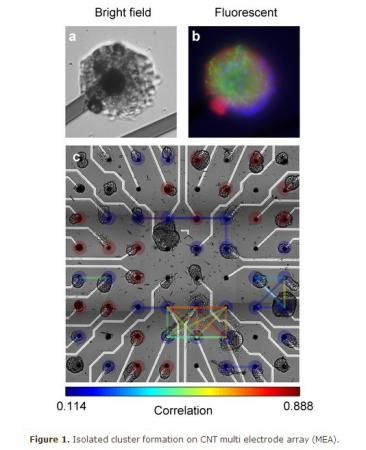摘要:研究人脑神经网络的通讯和协调运作,是现代神经科学领域最大的挑战之一。据美国物理学家组织网7月13日(北京时间)报道,最近,以色列特拉维夫大学电力工程学院开发出一种新型芯片实验室平台,利用先进材料和组织工程技术将神经元和电子学结合起来,研究脑神经网络的工作原理。研究论文发表在最新一期《科学公共图书馆—综合》(PLoS ONE)上。
以色列特拉维夫大学电力工程学院博士生马克·史恩说,计算机的逻辑运算建立在人类逻辑的基础上,但计算机的信息处理过程能分解成单个逻辑步骤,而人脑的信息处理过程却不可以。人脑由大量的电路互相连接而成,脑电路工作就像在编码,我们可以通过简化脑神经网络,控制细胞之间的连接,来研究人脑逻辑。
研究人员利用电极和活的神经细胞连接成一种特殊结构,让其在培养皿中生成各种大小不同的神经网络和网络群,并通过一种芯片实验室技术,在芯片上激活神经元电路,观察神经网络在不同化学信号和外部条件下的反应。
通过施加外部刺激,如一道亮光,研究人员能监控视觉神经元的反应。“我们认为这一过程采取了编码策略。”史恩说,相对简单的神经“点亮”方式能被耳朵、眼睛等感官接受,但对更复杂的过程,如“思想”过程或不同的感受器官同时输入、输出,基本还是个黑箱。
研究单个神经元的活动还难以理解整个神经网络的功能,史恩和导师约尔·汉恩教授、物理与天文学院的埃希尔·本-雅可布教授进一步对更大的神经网络电路进行了观察,以寻找大脑信息编码的基本元素。他们利用纳米技术系统工具,同时探测多个神经元的活动方式,特别探测了在大量神经会合的节点处多个神经群之间的沟通联系。
他们在观察这些神经群的时候发现,这些神经群的反应是只凭单个神经元无法预测的,这表示神经网络有一个等级结构,大网络由更小的次级网络构成。研究人员解释说,一个神经群要能支持神经网络的活动,并与其他群互相通讯,这最少需要40个神经元,才能完成其在功能网络中的各种任务。
研究人员还表示,他们开发的工具也可以用来测试新药,或作为一种先进的人工智能,并帮助连接大脑和人造义肢。

(a) A bright field image of a neuronal cluster on a CNT electrode. The electrode diameter is 30 µm and the inter electrode distance is 200 µm (b) A fluorescent microscope image of the cluster in (a), stained for cell nuclei (DAPI-blue), glia (GFAP-green) and neurons (TUJ1-red). (c) A bright field image of clusters on a MEA chip. Color coded lines show the Pearson correlation between the electrical activities of all cluster pairs above a threshold of 0.1. The electrically isolated clusters (red full circles) were distinguished from linked clusters (blue full circles) both functionally (no significant correlations to other clusters) and visually (no apparent extensions to other clusters).
生物探索推荐英文论文摘要:
Innate Synchronous Oscillations in Freely-Organized Small Neuronal Circuits
Abstract
Background
Information processing in neuronal networks relies on the network's ability to generate temporal patterns of action potentials. Although the nature of neuronal network activity has been intensively investigated in the past several decades at the individual neuron level, the underlying principles of the collective network activity, such as the synchronization and coordination between neurons, are largely unknown. Here we focus on isolated neuronal clusters in culture and address the following simple, yet fundamental questions: What is the minimal number of cells needed to exhibit collective dynamics? What are the internal temporal characteristics of such dynamics and how do the temporal features of network activity alternate upon crossover from minimal networks to large networks?
Methodology/Principal Findings
We used network engineering techniques to induce self-organization of cultured networks into neuronal clusters of different sizes. We found that small clusters made of as few as 40 cells already exhibit spontaneous collective events characterized by innate synchronous network oscillations in the range of 25 to 100 Hz. The oscillation frequency of each network appeared to be independent of cluster size. The duration and rate of the network events scale with cluster size but converge to that of large uniform networks. Finally, the investigation of two coupled clusters revealed clear activity propagation with master/slave asymmetry.
Conclusions/Significance
The nature of the activity patterns observed in small networks, namely the consistent emergence of similar activity across networks of different size and morphology, suggests that neuronal clusters self-regulate their activity to sustain network bursts with internal oscillatory features. We therefore suggest that clusters of as few as tens of cells can serve as a minimal but sufficient functional network, capable of sustaining oscillatory activity. Interestingly, the frequencies of these oscillations are similar those observed in vivo.







